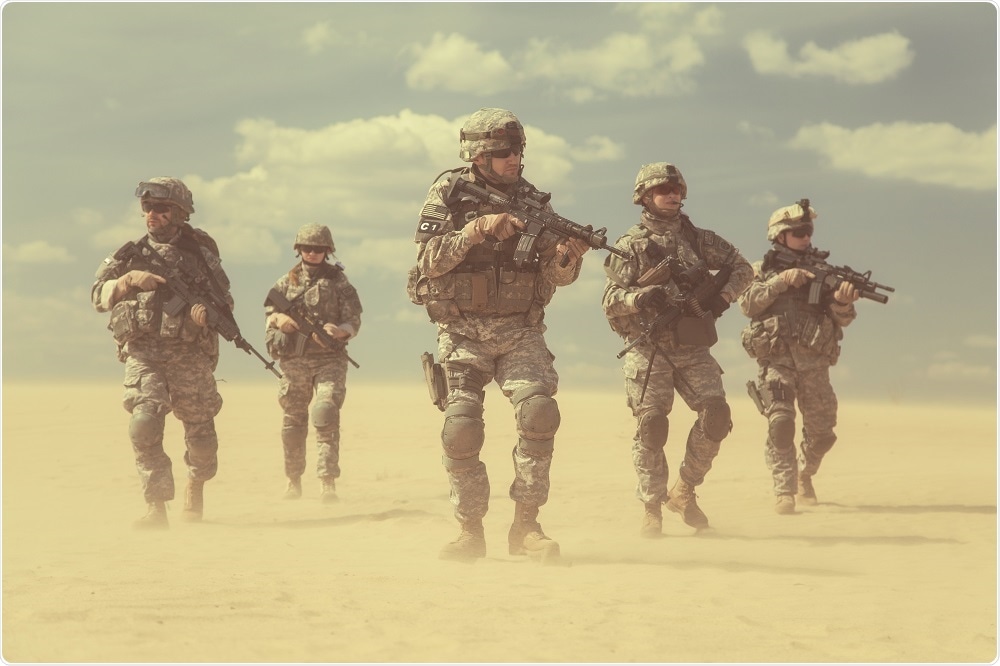An interview with Dr. Patricia Deuster, conducted by James Ives, MPsych
Please give an overview of the conditions that service members on active duty regularly experience when in combat in hot places such as the Middle East.
Since there are many official and unofficial terms for individuals who serve various roles in our military, we typically use the term warfighter.
It is common to think that combat deployment is the most dangerous part of being a warfighter, and in many ways this is correct. However, warfighters need to do many things before they are cleared to deploy to combat zones.

Most cases of exertional heat illness (EHI) reported in the U.S. military occur during non-combat activities, such as training regimens, ruck marches, and operational exercises.
EHI occurs during hard physical exertion often in the heat, when someone is unable to dissipate the external heat absorbed from the environment and the internal heat produced from working hard.
EHI comprises a complex of conditions, which range from relatively mild conditions such as heat syncope to more extreme conditions such as exertional heat stroke (EHS). EHS is life-threatening, and much of our research focuses on that.
How can high heat conditions affect service members? Does it affect service members equally?
Some warfighters definitely are at more of a risk than others. It's helpful to break risks down by intrinsic versus extrinsic factors.
Some intrinsic factors include a warfighter’s level of fitness, having suffered from previous heat strokes, and being sick. Some extrinsic risks include both heat and humidity, training exercises, and clothing and gear.
How often are service members affected by hyperthermic conditions such as heat stroke, swelling, fainting or malignant hyperthermia?
Every year, about 2000-3000 warfighters experience some form of EHI, and around 300-400 of these cases are EHS. Extreme cases of EHS can sometimes have comorbid factors such as exertional rhabdomyolysis.
What factors contribute to a higher likelihood of being affected by hyperthermic conditions? What makes a service member better at coping with high heat conditions?
One of the most important factors is how fit you are. If a warfighter is in good shape – that is, if he or she does not have an excess of body fat and is aerobically fit – then he or she will find physically demanding activities less strenuous, and therefore be at a reduced risk of EHI.
However, there is a bit of a conundrum here, because if an individual never goes out to engage in any physical activity, then risk for EHI is extremely low, until such activities are performed.
Tragically, it is occasionally the most motivated and physically fit warfighters – those who give it their all – who experience EHS, because they’re the ones who are pushing themselves to their physical limits. Ultimately, it is most important to be aware of your level of exertion and physical limits.
How do you test for these traits before putting service members into combat, where they could be at risk?
Each military service has specific guidelines for body composition and physical fitness. New recruits undergo basic training, and there are more specific training regimens tailored to specific occupational specialties.
These help to minimize the risk of EHI, but a lot also depends on a unit’s culture, its commanding officer, and the knowledge and resources available to mitigate risk in the field.
Is every service member tested for these traits before going into hot active military zones?
Every warfighter – including those in the Reserve and National Guard – are expected to maintain a baseline level of readiness in case he or she is called upon to deploy. Warfighters who deploy, however, undergo extra scrutiny in order to make sure they are fit to serve, although the specifics may differ based on service branch and job function.
Are service members tested after coming back from active duty? What differences are seen between pre and post tour activity?
Warfighters undergo regular annual testing to ensure that they meet baseline levels of fitness. Under select circumstances, those who experience EHS may undergo additional exercise testing, called heat tolerance testing (HTT), before they are returned back to physical duty.
When military physicians see a patient who is recovering from EHS, they need to determine whether it is acceptable for the patient to return to normal duties and resume physical activity. This can be a tricky decision, because there are no gold standard tests to help inform it.
Furthermore, it is a high-stakes decision because an individual’s military career is on the line, and physicians have to rely on their best clinical judgment. Much of our research is aimed at determining whether the HTT can help physicians make this decision.
HTTs are performed on a few dozen warfighters each year, although it is being written into more military medical recommendations. During HTTs, individuals walk or perform steady state exercise in the heat.
The purpose of a HTT is to determine whether an individual is able to physiologically adapt to exercise in the heat. HTTs are performed under uniform conditions, when patients are well-rested and hydrated. This helps to control for any external factors, such as combat gear, stress, etc.
How is thermal testing used to inform decisions on combat gear, such as uniforms and armor? Are service members tested in full gear before being sent into action?
HTTs are often used for clinical purposes, but they can also help to inform basic research. Some of our current research is investigating whether it is feasible to use a blood marker to help predict how people will respond to a HTT.
HTTs, or similar tests, can also help quantify the risk of developing EHI when exercising in the heat under various conditions. We recently completed a study where individuals underwent HTTs under different conditions, such as after taking a placebo or a caffeine pill. Other groups use HTTs to determine whether different clothing materials are more or less breathable.
How have the Physitemp Thermes Temperature Data Acquisition systems used to perform these tests?
Within our lab, we use data acquisition systems in order to monitor participants’ physiologic responses to exercise in the heat. The most important data point that we get from this system is core temperature.
Once a test is complete, we look at an individual’s maximal core temperature, along with the rate of rise in core temperature over the duration of the test. We want to make sure that, for an individual participant, his or her core temperature does not rise too quickly, and that core temperature “plateaus” over the duration of the test.
Over a test, an individual’s core temperature is expected to rise for the first 20-40 minutes, as he or she adapts to the heat. However, once someone starts to adjust to the heat and to sweat, their core temperature will level off and the rate of increase will slow down.
We use the other channels on the system to monitor skin temperature, which we measure at five locations: chest, shoulder, thigh, calf and tricep. Most often, we use skin temperature data to calculate mean body skin temperature.
Mean body skin temperature is the average surface temperature over someone’s body, and is calculated using weighted values from three or four skin sensors. As an individual starts to sweat, skin temperature will decrease, and core temperature will dissipate.
What is the protocol for using the Physitemp Thermes Data Acquisition System?
Our standard HTT protocol was developed by our Israeli colleagues and partners. It consists of two hours of treadmill walking at 3.1 miles per hour and at 2% incline. The test is conducted in a room where the temperature is set to 104 degrees Fahrenheit and 40% relative humidity.
During this test, we closely monitor core temperature and heart rate. We also quantify fluid intake to calculate sweat rate.
What advancements do you see in the future of service member temperature testing? What problems are you currently trying to solve?
One burgeoning area of research is looking into ways to use fitness monitors to predict heat strain in the field in real time, and unobtrusively. Some of our colleagues, for instance, are investigating whether this can be accomplished with compact sensors that measure skin chest temperature, heart rate, and movement, in combination with unique machine-learning algorithms.
This work is aimed at field-based applications, however a lot of work has to be put into validating these sensors and algorithms, and that is where our HTT Physitemp data fit in.
Our military partners, at the Biotechnology High Performance Computing Software Applications Institute, are using HTT data from our laboratory towards this end. It is a large undertaking because it requires expertise in physiology, engineering, computing, and military logistics.
Where can readers find more information?
Readers can find more information at the Uniformed Services University's Human Performance Resource Center (http://hprc-online.org/). This is a one-stop source of evidence-based information that we run. It has loads of information on different aspects of human performance that are relevant to warfighters, their families, and the general public.
About Dr. Patricia Deuster
Patricia Deuster, PhD, MPH, CNS, is a Professor and Director for the Consortium for Health and Military Performance (CHAMP) in the Department of Military and Emergency Medicine, and for the Human Performance Resource Center (HPRC), at the Uniformed Services University of the Health Sciences, Bethesda, MD.
She was the author of the first U.S. Navy SEAL Nutrition Guide sponsored by U.S. Special Operations Command and, because of its success, was commissioned to update the nutrition guide for the United States Special Operations Commands (USSOCOM).
Dr. Deuster, a Certified Nutrition Specialist, has conducted research in the area of sports and warrior nutrition for over 25 years and has published well over 100 peer-reviewed papers relating to stress, nutrition, and physical performance in the military.
She has been a tennis professional, nationally ranked marathoner, qualifier for the First Women's Olympic Marathon Trials, triathlete, skydiver with over 100 jumps, and world-wide scuba diver. In addition, she is an invited speaker throughout the country on sports nutrition and performance.